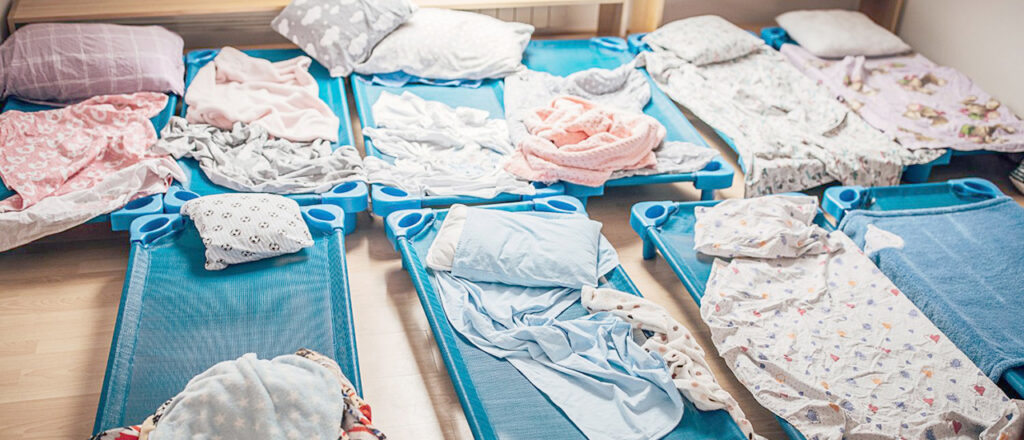Early Childhood Educators agree that naptime is essential to a successful early childhood program. Naptime in early childhood is crucial for children’s neurology for several reasons. For young children, who are rapidly developing cognitively, naptime provides an essential period for their brains to process new information and solidify learning experiences from the day. Naptime also supports emotional regulation in children, a chance for children to recharge, leading to more balanced emotional responses and improved social interactions. Naptime in an early childhood classroom is essential for children’s neurology because it supports brain development, emotional regulation, physical growth, cognitive functioning, behavioral regulation, and overall well-being. Providing a consistent and conducive naptime environment can have long-lasting positive effects on children’s development and learning outcomes.
One of the biggest challenges to a successful naptime in an early childhood classroom is transitioning from lunch to napping. Since naptime usually comes after lunch and includes toileting and putting out cots or mats, creating a smooth and calming transition for children is challenging. The smoother it is for teachers, the easier and more relaxing it will be for children.

Daily routines offer children a sense of consistency and security.
Look beyond the many small tasks that make up naptime. What can you do to create an environment of relaxation and to help release children from the activities and tensions of the day? Here are some suggestions:
Work with the other adults in the room to create transitions to naptime that work for the teachers and children. With your team, develop routines that you can maintain consistently. Make a list of the tasks that you need to accomplish in the time that you have. It may help to create consistent groups of children you know can transition well together. There are many tasks to complete while creating a relaxing environment for the children.
Since naptime typically follows lunch, the transition to naptime starts at lunch. Tasks after lunch include cleaning up, toileting, putting out cots, pillows, etc. Remember, it’s not a teacher’s job to do tasks children can do for themselves. Guiding and supporting them in doing tasks independently builds their self-confidence. They will learn classroom routines and be able to accomplish them. During this critical transition, a general rule of thumb is to have the children occupied and preparing for a nap rather than engaged in unstructured time.

Here are some general guidelines for transitioning to naptime:
Understand that it starts at lunch. Since children finish eating at different times when children finish eating, what do they do next? Toileting is often next, reminding them to wash their hands and faces. An adult needs to be close by. Perhaps one teacher is on the rug, gathering students for a quiet game or story.
Use music to indicate the change from lunch to nap. Play soft music to indicate the change in activity from lunch to nap. When the music goes on, voices go soft.
Label cots, mats, pillows, and stuffed toys so children can easily identify them.
Tips for helping children relax on their cots or mats:
1. Read a napping story. Read more slowly than you might usually and choose a calming voice.
2. Sing lullabies to them.
3. Play soft music.
4. Rhythmic breathing.
You lead this with your own breathing and will have to exaggerate the sound of your breath. Breathe in through your nose and out through your nose. Breathe in and out slowly at a count of 3 if you can.
5. Relaxing their bodies.
Walk through the body parts with your nappers. Go slowly.
a. Feel your toes; relax your toes.
b. Feel your fingers, relax your fingers.
c. Feel your legs, relax your legs.
This pattern continues going from the outmost parts of the body to the center of the body.
6. Tell children a story that acts as a visualization. Take them on an imaginary calming walk.
7. Finally, remind children that they are safe napping at school and that you are watching over them.
What to do for non-nappers:
Some days, a child cannot nap. Not napping can be the result of many factors. You may understand some of them; others may not. If you don’t have a separate space, children who remain awake can choose to rest on a cot or move to an area of the room and select a quiet activity.
Quiet activities include books, lacing boards, busy boards, small felt boards and shapes, puzzles, pegboards, drawing, or writing. A teacher staying near this area can guide children and ensure they are engaged. Children can understand that some friends need to rest so that they will use their quiet time skills.
Children in childcare often have long days. Naptime allows children to rest and recharge, which is essential for their physical, emotional, and mental health.
Discover more about fostering a nurturing environment in early childhood education.
Elevate your understanding of early childhood education and child development with my engaging preschool education workshops tailored for both teachers and parents. These workshops provide valuable insights, practical strategies, and effective tools to enhance your role in nurturing young minds. Whether you’re an educator or a parent, these sessions aim to empower you with the knowledge and skills essential for fostering a positive learning environment. Dive deeper into the world of preschool education and child development by exploring my workshop offerings. For more valuable content and updates, follow me on Instagram and connect with me on LinkedIn. #EarlyYearsConsult
#EarlyChildhoodEducation #ChildDevelopment #PreschoolWorkshops #EducatorServices #ParentingTips #LearnAndGrow

